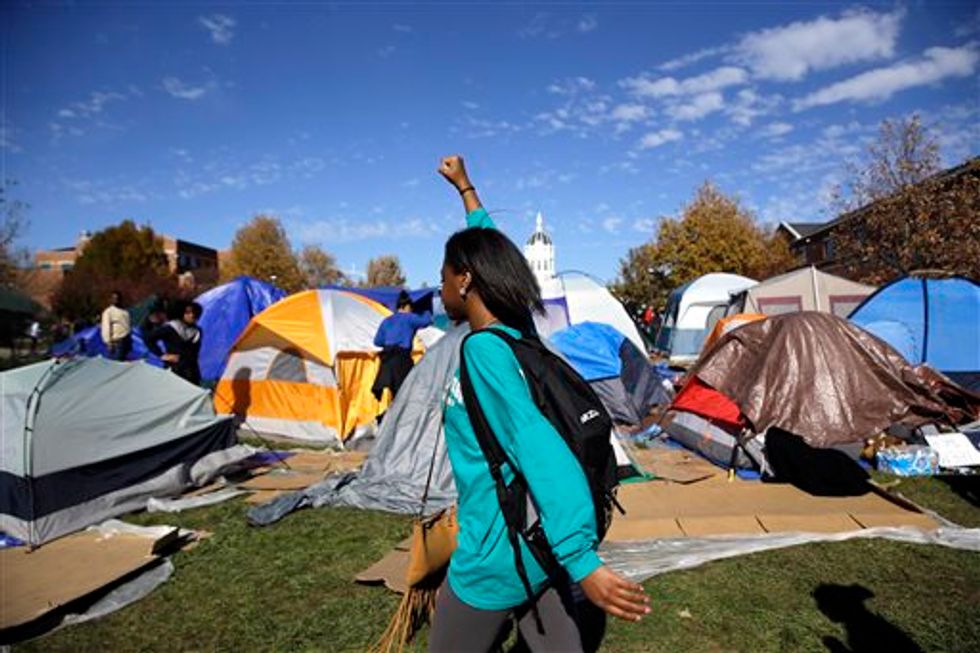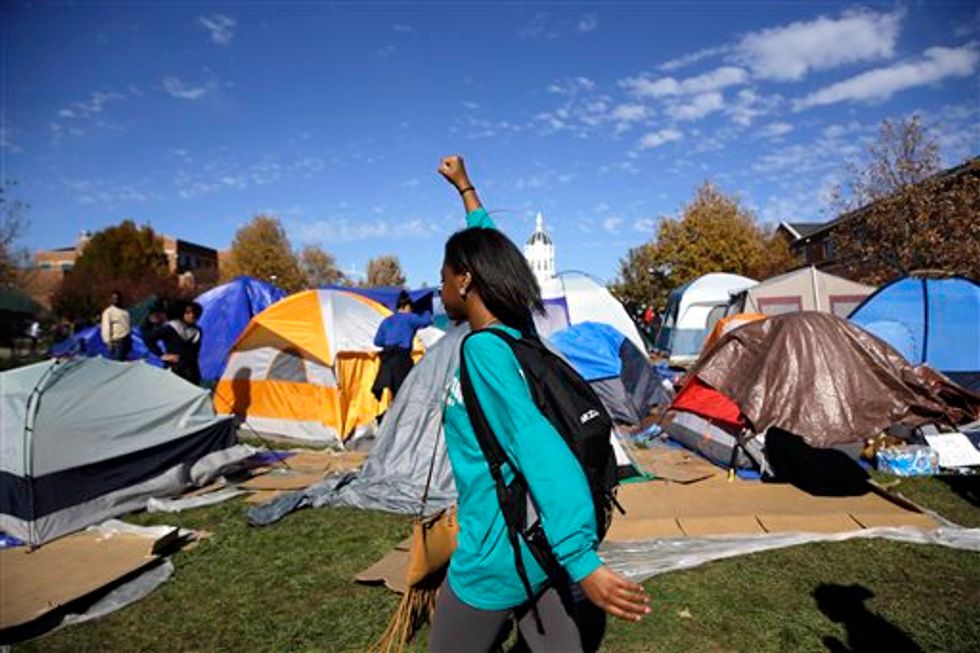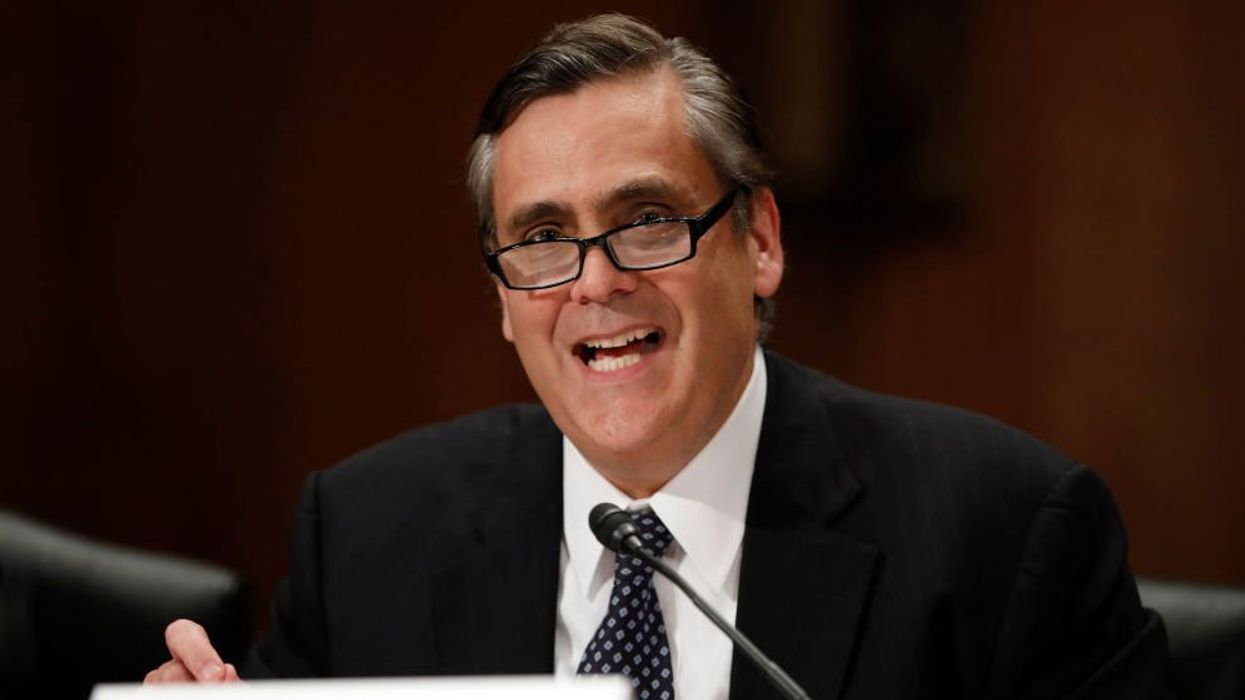The protests at the University of Missouri over a racial incident have compelled the resignation of the two leading campus officers. For any campus administration to take responsibility for the excesses of some unknown racist or racists shows how hypersensitive racial issues are on campus. Indeed, there is something ironic if not absurd about the entire affair. Can you imagine the head of Macy’s, for example, resigning because someone walked into a bathroom and smeared an offensive racist symbol on a mirror?
From the zealous use of affirmative action in student recruitment, to the tortured concerns about insulating minority students from dealing with issues that might be hurtful, and the creation of entire bureaucratic structures designed to serve minority needs, no societal institution has been as ostensibly responsive to minority problems as have been universities.
 A woman passes a tent encampment set up by student protesters following an announcement that University of Missouri System President Tim Wolfe is resigning Monday, Nov. 9, 2015, at the university in Columbia, Mo. Wolfe resigned Monday with the football team and others on campus in open revolt over his handling of racial tensions at the school. (AP Photo/Jeff Roberson)
A woman passes a tent encampment set up by student protesters following an announcement that University of Missouri System President Tim Wolfe is resigning Monday, Nov. 9, 2015, at the university in Columbia, Mo. Wolfe resigned Monday with the football team and others on campus in open revolt over his handling of racial tensions at the school. (AP Photo/Jeff Roberson)
So why is it that in this leftist-dominated environment, which incessantly pushes the envelope of racial concerns, does the cauldron of racial tension seem to be perpetually boiling over?
The typical answers can be divided into two types: universities, with their obsession about race have socialized a group of immature students either to get their way or protest. Or, universities are only superficially accommodating to the issues that emerge from a racist society. In reality, however, they are just another component of institutionalized racism.
There are seeds of truth in both these explanations and there are historical reasons for them.
On the floor of the Senate, Hubert Humphrey, who was the lead author of the historic 1964 Civil Rights Act, proclaimed that if the legislation contained language mandating racial quotas, he would stand before the Senate and eat the bill page by page. Few doubted Humphrey’s sincerity in making this statement.
The creation of Affirmative Action by President Lyndon Johnson’s executive order, which was based on the 1964 Civil Rights Act, ultimately did result in quotas. Although Johnson, as Humphrey, was interested in creating equality of opportunity, that vaunted goal was transformed by black interest-group pressure into equality of result. What started out as an aspiration became a mandatory obligation.
At every level of prestige, universities embarked on rigorous campaigns of affirmative action recruiting. Although described euphemistically as goals, the failure to meet such goals were not without consequences, and the goals de facto became quotas.
To fill these quotas, universities lowered standards, with the most prestigious universities reaching down to levels they would generally never consider for non-minority students.
Elite universities siphon off students who would comfortably succeed at good, solid public institutions and pushed them into unfair competition with students in the upper reaches of academic talent.
The system does not advance the interests of black students but exploited them so that university administrations could make their numbers.
As Thomas Sowell appropriately admonished black students—you have an education to get; university administrators have a quota to fill. Administrators are checking off racial boxes, while black students are searching for an education. Those are not the compatible interests.
Indeed, they are not!
African-American students are too often condemned to a dismal and unnecessarily frustrating academic experience because of a clumsy mismatch that serves the interests of pressure groups and university administrations but not those of the students. As Sowell notes, most students who take calculus at a solid, public university can successfully complete the course, but put a good although not exceptional student into a calculus course at Massachusetts Institute of Technology, where the first three weeks are equivalent to an entire semester at a good university, and you have a recipe for frustration and failure.
More than 25 percent of black students fail to graduate MIT, but there is little doubt that most of those would likely excel at a public university. The mismatch—which is repeated at all levels of the higher education system—exploit black students for record keeping.
This frustration and failure produces anger, and that anger manifests itself in racial hypersensitivity that leads to protest. It is a simple example of the frustration/aggression hypothesis used in studies of political violence: the greater the anger the greater the propensity toward aggression.
Almost no one would argue that racism does not exist on campus or trivialize its occurrence, but universities have built the equivalent of standing armies to be mobilized against such episodes. No where in our society is there more concern with racism than in our universities.
The exposure of students to Orwellian sensitivity sessions, often conducted by people for whom the word charlatan would be a compliment, instills in minorities a misplaced sense of power: the ability to quash an argument, overturn a class discussion, or shakeup an academic career by casually and sometimes ruthlessly hurling an accusation of racism in public. Many a class discussion comes to abrupt silence with such nonsensical statements as: check your privilege, that’s racist, or a white person cannot possibly understand the problems of black people.
Socializing young, immature, students into a power relationship based on ascription and mixing that with the frustrations many black students experience as a consequence of institutional exploitation creates a volatile situation that makes them ripe for mobilization for protest.
The campus exploits black students to fill quotas, and then gives them simultaneously an incongruous feeling of power and victimization.
Too many black students come from failing schools. Their problems will not be solved with bureaucratic gaming, but through an honest investment in resources to provide the remediation to equip them with the skills they need to succeed in college. That means a real and serious investment in remediation and assistance and not the creation of another deanship of diversity and opportunity. The latter is window dressing and public relations. The former requires a real commitment of resources and a heartfelt appreciation for the problems many blacks bring with them to college.
–
TheBlaze contributor channel supports an open discourse on a range of views. The opinions expressed in this channel are solely those of each individual author.


 A woman passes a tent encampment set up by student protesters following an announcement that University of Missouri System President Tim Wolfe is resigning Monday, Nov. 9, 2015, at the university in Columbia, Mo. Wolfe resigned Monday with the football team and others on campus in open revolt over his handling of racial tensions at the school. (AP Photo/Jeff Roberson)
A woman passes a tent encampment set up by student protesters following an announcement that University of Missouri System President Tim Wolfe is resigning Monday, Nov. 9, 2015, at the university in Columbia, Mo. Wolfe resigned Monday with the football team and others on campus in open revolt over his handling of racial tensions at the school. (AP Photo/Jeff Roberson)


